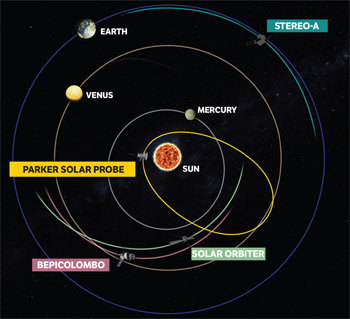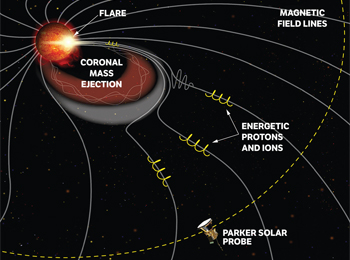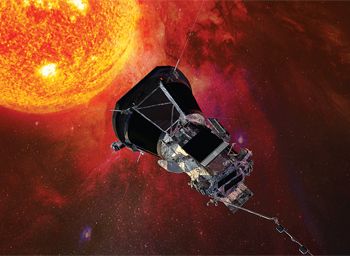INDIAN ARMED FORCES CHIEFS ON
OUR RELENTLESS AND FOCUSED PUBLISHING EFFORTS

SP Guide Publications puts forth a well compiled articulation of issues, pursuits and accomplishments of the Indian Army, over the years

I am confident that SP Guide Publications would continue to inform, inspire and influence.

My compliments to SP Guide Publications for informative and credible reportage on contemporary aerospace issues over the past six decades.
Inching Closer to Our Solar System’s Source
In a first and historic feat, a spacecraft has reached the Sun

Space exploration is expanding the envelope like never before as humanity continues to reach farther and farther into the space. This time the destination being the centre of our solar system, the Sun. The National Aeronautics and Space Administration (NASA)’s Parker Solar Probe managed to fly through the Sun’s upper atmosphere – the corona. NASA’s Parker Solar Probe was launched to space in August 2018. Three years after launch and decades after first conception, Parker finally reached. It has become the closest-ever spacecraft to the Sun. Loaded with scientific instruments to measure the environment around the spacecraft, Parker Solar Probe has completed three of 24 planned passes through never-before-explored parts of the Sun’s atmosphere, the corona. Parker Solar Probe is part of NASA’s Living with a Star programme to explore aspects of the Sun-Earth system that directly affect life and society.
The findings shared by Parker will aid scientists in coming closer to answering fundamental questions about the physics of our star. They also reveal new information about the behavior of the material and particles that speed away from the Sun. In the quest to protect astronauts and technology in space, the information Parker has uncovered about how the Sun constantly ejects material and energy will help scientists re-write the models used to understand and predict the space weather around our planet and understand the process by which stars are created and evolve, NASA stated. Parker’s discoveries also include those from within the solar wind – the flow of particles from the Sun that can influence us at Earth.
Just like landing on the Moon allowed scientists to understand how it was formed, touching the very stuff the Sun is made of will help scientists unveil critical information about our closest star and its influence on the solar system.
Thomas Zurbuchen, the associate administrator for the Science Mission Directorate at NASA Headquarters in Washington said, “Not only does this milestone provide us with deeper insights into our Sun’s evolution and its impacts on our solar system, but everything we learn about our own star also teaches us more about stars in the rest of the universe.”
CLOSER THAN EVER BEFORE
Unlike our Earth, there is no solid surface of the Sun. However, the sun does have a superheated atmosphere that comprises of solar material bound to it by gravity and magnetic forces. As rising heat and pressure push that material away from the Sun, it reaches a point where gravity and magnetic fields are too weak to contain it. That point, known as the Alfvén critical surface, is where the solar atmosphere ends and the solar wind begins. Solar material with the energy to make it across that boundary becomes the solar wind, which drags the magnetic field of the Sun with it as it races across the solar system, to Earth and beyond.

During the flyby, Parker Solar Probe passed into and out of the corona several times. This is proved what some had predicted – that the Alfvén critical surface isn’t shaped like a smooth ball. Rather, it has spikes and valleys that wrinkle the surface. Discovering where these protrusions line up with solar activity coming from the surface can help scientists learn how events on the Sun affect the atmosphere and solar wind.
The first passage through the corona, which lasted only a few hours, is one of many planned for the mission. Parker will continue to spiral closer to the Sun, eventually reaching as close as 8.86 solar radii (3.83 million miles) from the surface. Upcoming flybys, the next of which is happening in January 2022, will likely bring Parker Solar Probe through the corona again.
The size of the corona is also driven by solar activity. As the Sun’s 11-year activity cycle – the solar cycle – ramps up, the outer edge of the corona will expand, giving Parker Solar Probe a greater chance of being inside the corona for longer periods of time.
Parker’s first passage through the corona – and the promise of more flybys to come – will continue to provide data on phenomena that are impossible to study from afar. It is noteworthy that even though Parker has reached the Sun recently, it has been sharing important information during its journey.
Earlier this year, during a brief swing by Venus, NASA’s Parker Solar Probe allowed scientists the first direct measurement of the Venusian atmosphere in nearly 30 years — and it looked quite different from Venus’ past. The Probe also provided scientists the first complete look at Venus’ orbital dust ring, a collection of microscopic dust particles that circulates around the Sun along Venus’ orbit. In 2019, Parker had discovered that magnetic zig-zag structures in the solar wind, called switchbacks, are plentiful close to the Sun. However, the origin of these structures remained a mystery.
ORIGINS OF SWITCHBACKS
When NASA’s Parker Solar Probe sent back the first observations from its journey to the Sun, scientists found signs of a wild ocean of currents and waves that were unlike those near-Earth space. This ocean was spiked with what became known as switchbacks: rapid flips in the Sun’s magnetic field that reversed direction like a zig-zagging mountain road. Scientists think piecing together the story of switchbacks is an important part of understanding the solar wind. The solar wind races through the solar system, shaping a vast space weather system, which we regularly study from various vantage points around the solar system.
Now, Parker Solar Probe has passed close enough to that origin: the solar surface. On recent solar encounters, the Probe collected data pinpointing the origin of switchbacks, showing one spot that switchbacks originate is at the visible surface of the Sun – the photosphere.

By the time it reaches Earth, 93 million miles away, the solar wind is an unrelenting headwind of particles and magnetic fields. But as it escapes the Sun, the solar wind is structured and patchy, revealed NASA. In the mid-1990s, the NASA-European Space Agency (ESA) mission Ulysses flew over the Sun’s poles and discovered a handful of bizarre S-shaped kinks in the solar wind’s magnetic field lines, which detoured charged particles on a zigzag path as they escaped the Sun. For decades, scientists thought these occasional switchbacks were oddities confined to the Sun’s Polar Regions. However, in 2019, at 34 solar radii from the Sun, Parker discovered that switchbacks were not rare, but common in the solar wind. As Parker orbited closer to the Sun on its sixth flyby, less than 25 solar radii out, data showed switchbacks occur in patches and have a higher percentage of helium – known to come from the photosphere – than other elements. The switchbacks’ origins were further narrowed when the scientists found the patches aligned with magnetic funnels that emerge from the photosphere between convection cell structures called super granules. In addition to being the birthplace of switchbacks, the scientists think the magnetic funnels might be where one component of the solar wind originates.
Understanding where and how the components of the fast solar wind emerge is likely to help scientists answer a longstanding solar mystery: how the corona is heated to millions of degrees, far hotter than the solar surface below. Parker’s closer passes may reveal even more clues about switchbacks and other solar phenomena as well as allow scientists a glimpse into a region that’s critical for superheating the corona and pushing the solar wind to supersonic speeds. Such measurements from the corona will be critical for understanding and forecasting extreme space weather events that can disrupt telecommunications and damage satellites around Earth.
WHY STUDY THE SUN?
There are two ways in which the sun releases energy. One is the usual flow of light that illuminates the Earth and makes life possible but there are also more violent and dramatic ways in which sun gives off bursts of light, particles, and magnetic fields that can have ripple effects all the way out to the solar system’s magnetic edge.
The primary science goals for the mission, charted out by NASA, are to trace how energy and heat move through the solar corona and to explore what accelerates the solar wind as well as solar energetic particles. “Scientists have sought these answers for more than 60 years, but the investigation requires sending a probe right through the 2,500 degrees Fahrenheit heat of the corona. Parker Solar Probe carries four instrument suites designed to study magnetic fields, plasma and energetic particles, and image the solar wind,” stated NASA.
NASA’s Parker Solar Probe was launched to space in August 2018
The international agency informs that the sun’s activity and conditions vary on almost every timescale, from tiny changes that happen over milliseconds, to solar eruptions that last hours or days, to its 27-day rotation. The solar magnetic field cycles through a complete change in direction and back about every 22 years, which in turn gives rise to the roughly 11-year cycle in solar activity. As magnetic field becomes more complex, it releases energy near the solar surface. These solar explosions can take the form of solar flares, coronal mass ejections, or releases of incredibly fast charged particles that race out from the sun at nearly the speed of light.
NASA states that it studies the sun:
- Sun is the only star we can study up close. Studying our sun allows us to be informed and research about other stars throughout the universe.
- To have a better understanding about how sun’s everchanging conditions can influence Earth, other worlds, and even space itself.
- To understand its influence on the habitability of Earth as that is incredibly complex. The radiation that we receive from the sun, depending on the amount, can be either a boon or hazard to the development of life.
- This radiation, and the accompanying energy and magnetic fields that the sun sends out is intense and dynamic, with the ability to create changes in the space weather around us.
- Space weather can change the orbits of satellites, shorten their lifetimes, or interfere with onboard electronics. The more we learn about what causes space weather – and how to predict it – the more we can protect the satellites we depend on. The radiations even hold the possibility to interfere with our space technology and communications systems.

PARKER SOLAR PROBE INSTRUMENTS
Parker Solar Probe is performing under extreme conditions while gathering data in the Sun’s corona, grazing closer to our star than any spacecraft before. Its four instrument suites characterise the dynamic region close to the Sun by measuring particles and electric and magnetic fields, and each was specially designed to withstand the harsh radiation and temperatures they will encounter.
FIELDS
The FIELDS instrument suite captures the scale and shape of electric and magnetic fields in the Sun’s atmosphere. FIELDS measures waves and turbulence in the inner heliosphere with high time resolution to understand the fields associated with waves, shocks and magnetic reconnection, a process by which magnetic field lines explosively realign. FIELDS measures the electric field around the spacecraft with five antennas, four of which stick out beyond the spacecraft’s heat shield and into the sunlight, where they experience temperatures of 2,500 F. The 2-meter-long antennas are made of a niobium alloy, which can withstand extreme temperatures. Operating in two modes, the four sunlit antennas measure the properties of the fast and slow solar wind. The fifth antenna, which sticks out perpendicular to the others in the shade of the heat shield, helps make a three-dimensional picture of the electric field at higher frequencies.
WISPR
The Wide-Field Imager for Parker Solar Probe (WISPR) is the only imaging instrument aboard the spacecraft. WISPR looks at the large-scale structure of the corona and solar wind before the spacecraft flies through it. About the size of a shoebox, WISPR takes images from afar of structures like coronal mass ejections, or CMEs, jets and other ejecta from the Sun. To image the solar atmosphere, WISPR uses the heat shield to block most of the Sun’s light, which would otherwise obscure the much fainter corona. WISPR uses two cameras with radiation-hardened Active Pixel Sensor CMOS detectors. These detectors are used in place of traditional CCDs because they are lighter and use less power. They are also less susceptible to effects of radiation damage from cosmic rays and other high-energy particles, which are a big concern close to the Sun.
SWEAP
The Solar Wind Electrons Alphas and Protons investigation, or SWEAP, gathers observations using two complementary instruments: the Solar Probe Cup, or SPC, and the Solar Probe Analyzers, or SPAN. The instruments count the most abundant particles in the solar wind — electrons, protons and helium ions — and measure such properties as velocity, density, and temperature to improve our understanding of the solar wind and coronal plasma.
ISOIS
The Integrated Science Investigation of the Sun (ISOIS) is pronounced “ee-sis” and includes the symbol for the Sun in its acronym. It uses two complementary instruments in one combined scientific investigation to measure particles across a wide range of energies. By measuring electrons, protons and ions, ISOIS will understand the particles’ lifecycles — where they came from, how they became accelerated and how they move out from the Sun through interplanetary space. The two energetic particle instruments on ISOIS are called EPI-Lo and EPI-Hi (EPI stands for Energetic Particle Instrument).
Studying our sun allows us to be informed and research about other stars throughout the universe; about life and habitability on Earth, about space weather in the solar system and more
While Parker continues on its journey of exploring the Sun, India’s space agency, Indian Space Research Organisation (ISRO) is also gearing up for its own mission to the sun called, Aditya-1. Expected to launch next year, Aditya-1 was earlier meant to observe only the solar corona. The outer layers of the Sun, extending to thousands of km above the disc (photosphere) is termed as the corona. However, with additional experiments the spacecraft can now provide observations of Sun’s Corona (soft and hard X-ray, Emission lines in the visible and NIR), Chromosphere (UV) and photosphere (broadband filters), ISRO had put out.





